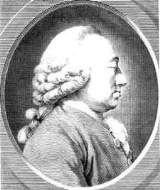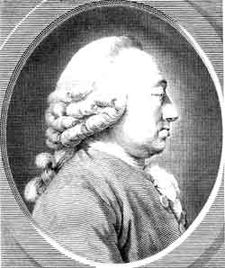
Charles Bonnet syndrome
Encyclopedia
Charles Bonnet syndrome (CBS) is a condition that causes patients with visual loss to have complex visual hallucinations, first described by Charles Bonnet
in 1760 and first introduced into English-speaking psychiatry
in 1982.
people with often significant visual loss, have vivid, complex recurrent visual hallucination
s (fictive visual percepts). One characteristic of these hallucinations is that they usually are "lilliput
hallucinations" (hallucinations in which the characters or objects are smaller than normal). The most common hallucination is of faces or cartoonsSufferers understand that the hallucinations are not real, and the hallucinations are only visual, that is, they do not occur in any other senses, e.g.: hearing, smell or taste. Among older adults (>65 years) with significant vision loss, the prevalence of Charles Bonnet syndrome has been reported to be between 10% and 40%; a recent Australian study has found the prevalence to be 17.5%. Two Asian studies, however, report a much lower prevalence. The high incidence of non-reporting of this disorder is the greatest hindrance to determining the exact prevalence; non-reporting is thought to be as a result of sufferers being afraid to discuss the symptoms out of fear that they will be labelled insane.
People suffering from CBS may experience a wide variety of hallucinations. Images of complex colored patterns and images of people are most common, followed by animals, plants or trees and inanimate objects. The hallucinations also often fit into the person's surroundings.
s due to old age or damage to the eye
s or optic pathways
. In particular, central vision loss due to a condition such as macular degeneration
combined with peripheral vision loss from glaucoma
may predispose to CBS, although most people with such deficits do not develop the syndrome. The syndrome can also develop after bilateral optic nerve damage due to methyl alcohol poisoning.
s may be helpful.
 The disease is named after the Swiss naturalist
The disease is named after the Swiss naturalist
Charles Bonnet
, who described the condition in 1769. He first documented it in his 89-year-old grandfather who was nearly blind from cataract
s in both eyes but perceived men, women, birds, carriages, buildings, tapestries, physically-impossible circumstances and scaffolding patterns.
's book Phantoms in the Brain and in Vikram Chandra
's book Sacred Games. Ramachandran suggests that James Thurber
, who was blinded in one eye as a child, may have derived his extraordinary imagination from the syndrome.
Charles Bonnet
Charles Bonnet , Swiss naturalist and philosophical writer, was born at Geneva, of a French family driven into Switzerland by the religious persecution in the 16th century.-Life and work:Bonnet's life was uneventful...
in 1760 and first introduced into English-speaking psychiatry
Psychiatry
Psychiatry is the medical specialty devoted to the study and treatment of mental disorders. These mental disorders include various affective, behavioural, cognitive and perceptual abnormalities...
in 1982.
Characteristics
Sufferers, who are mentally healthyMental health
Mental health describes either a level of cognitive or emotional well-being or an absence of a mental disorder. From perspectives of the discipline of positive psychology or holism mental health may include an individual's ability to enjoy life and procure a balance between life activities and...
people with often significant visual loss, have vivid, complex recurrent visual hallucination
Hallucination
A hallucination, in the broadest sense of the word, is a perception in the absence of a stimulus. In a stricter sense, hallucinations are defined as perceptions in a conscious and awake state in the absence of external stimuli which have qualities of real perception, in that they are vivid,...
s (fictive visual percepts). One characteristic of these hallucinations is that they usually are "lilliput
Lilliput
Lilliput has several meanings:* Lilliput and Blefuscu, two island nations in Jonathan Swift's novel Gulliver's Travels* The genus of jumping spiders of this name was renamed to Tanzania in 2008...
hallucinations" (hallucinations in which the characters or objects are smaller than normal). The most common hallucination is of faces or cartoonsSufferers understand that the hallucinations are not real, and the hallucinations are only visual, that is, they do not occur in any other senses, e.g.: hearing, smell or taste. Among older adults (>65 years) with significant vision loss, the prevalence of Charles Bonnet syndrome has been reported to be between 10% and 40%; a recent Australian study has found the prevalence to be 17.5%. Two Asian studies, however, report a much lower prevalence. The high incidence of non-reporting of this disorder is the greatest hindrance to determining the exact prevalence; non-reporting is thought to be as a result of sufferers being afraid to discuss the symptoms out of fear that they will be labelled insane.
People suffering from CBS may experience a wide variety of hallucinations. Images of complex colored patterns and images of people are most common, followed by animals, plants or trees and inanimate objects. The hallucinations also often fit into the person's surroundings.
Causes
CBS predominantly affects people with visual impairmentVisual impairment
Visual impairment is vision loss to such a degree as to qualify as an additional support need through a significant limitation of visual capability resulting from either disease, trauma, or congenital or degenerative conditions that cannot be corrected by conventional means, such as refractive...
s due to old age or damage to the eye
Human eye
The human eye is an organ which reacts to light for several purposes. As a conscious sense organ, the eye allows vision. Rod and cone cells in the retina allow conscious light perception and vision including color differentiation and the perception of depth...
s or optic pathways
Optic nerve
The optic nerve, also called cranial nerve 2, transmits visual information from the retina to the brain. Derived from the embryonic retinal ganglion cell, a diverticulum located in the diencephalon, the optic nerve doesn't regenerate after transection.-Anatomy:The optic nerve is the second of...
. In particular, central vision loss due to a condition such as macular degeneration
Macular degeneration
Age-related macular degeneration is a medical condition which usually affects older adults and results in a loss of vision in the center of the visual field because of damage to the retina. It occurs in “dry” and “wet” forms. It is a major cause of blindness and visual impairment in older adults...
combined with peripheral vision loss from glaucoma
Glaucoma
Glaucoma is an eye disorder in which the optic nerve suffers damage, permanently damaging vision in the affected eye and progressing to complete blindness if untreated. It is often, but not always, associated with increased pressure of the fluid in the eye...
may predispose to CBS, although most people with such deficits do not develop the syndrome. The syndrome can also develop after bilateral optic nerve damage due to methyl alcohol poisoning.
Prognosis
There is no treatment of proven effectiveness for CBS. It usually disappears within a year or 18 months, but this can vary greatly from person to person. Some people experience CBS for anywhere from a few days up to many years, and these hallucinations can last only a few seconds or continue for most of the day. For those experiencing CBS, knowing that they are suffering from this syndrome and not a mental illness seems to be the best treatment so far, as it improves their ability to cope with the hallucinations. Most people with CBS meet their hallucinations with indifference, but they can still be disturbing because they may interfere with daily life. It seems that there are a few activities that can make the hallucinations stop although many people are not aware of these. Interrupting vision for a short time by closing the eyes or blinking is sometimes helpful.Treatment
Because there is no prescribed treatment, the physician will consider on a case by case basis whether to treat any depression or other problems that may be related to CBS. A recent case report suggests selective serotonin reuptake inhibitorSelective serotonin reuptake inhibitor
Selective serotonin re-uptake inhibitors or serotonin-specific reuptake inhibitor are a class of compounds typically used as antidepressants in the treatment of depression, anxiety disorders, and some personality disorders. The efficacy of SSRIs is disputed...
s may be helpful.
History

Natural history
Natural history is the scientific research of plants or animals, leaning more towards observational rather than experimental methods of study, and encompasses more research published in magazines than in academic journals. Grouped among the natural sciences, natural history is the systematic study...
Charles Bonnet
Charles Bonnet
Charles Bonnet , Swiss naturalist and philosophical writer, was born at Geneva, of a French family driven into Switzerland by the religious persecution in the 16th century.-Life and work:Bonnet's life was uneventful...
, who described the condition in 1769. He first documented it in his 89-year-old grandfather who was nearly blind from cataract
Cataract
A cataract is a clouding that develops in the crystalline lens of the eye or in its envelope, varying in degree from slight to complete opacity and obstructing the passage of light...
s in both eyes but perceived men, women, birds, carriages, buildings, tapestries, physically-impossible circumstances and scaffolding patterns.
Society and culture
The syndrome is discussed in Vilayanur S. RamachandranVilayanur S. Ramachandran
Vilayanur Subramanian "Rama" Ramachandran, born 1951, is a neuroscientist known for his work in the fields of behavioral neurology and visual psychophysics...
's book Phantoms in the Brain and in Vikram Chandra
Vikram Chandra
Vikram Chandra is an Indian writer. His first novel, Red Earth and Pouring Rain, won the 1996 Commonwealth Writers' Prize, Best First Book....
's book Sacred Games. Ramachandran suggests that James Thurber
James Thurber
James Grover Thurber was an American author, cartoonist and celebrated wit. Thurber was best known for his cartoons and short stories published in The New Yorker magazine.-Life:...
, who was blinded in one eye as a child, may have derived his extraordinary imagination from the syndrome.
External links
- Information on Charles Bonnet syndrome from RNIB
- Fortean Times article on Charles Bonnet syndrome
- 'Damn Interesting' article on Charles Bonnet syndrome
- Mentioned in a radio article on The Blindfold Study, which is looking at the brain's ability to adapt to different stimuli.
- National Public Radio article with an audio segment about Charles Bonnet syndrome
- Charles Bonnet syndrome
- Complications of macular degeneration
- The Charles Bonnet syndrome: 'phantom visual images'
- Harmless Hallucinations in the Elderly by Bernard Baars (From: Science and Consciousness Review)
- Ghostly faces and visions of 'little people': The eye disorder that leaves thousands of Britons fearing they've lost their senses by Morag Preston (From: DailyMail)
- Oliver Sacks: What hallucination reveals about our minds Ted Talk, Feb 2009.

